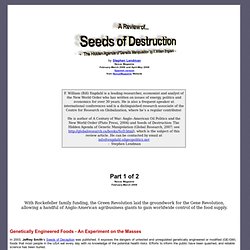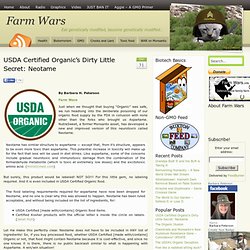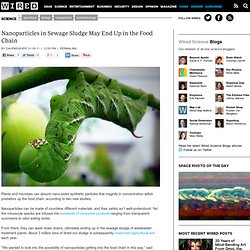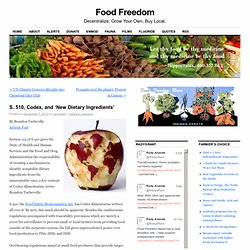

Seeds Of Destruction - A Review of 'Seeds of Destruction - The Hidden Agenda of Genetic Manipulation' by F.William Engdahl. By Stephen Lendman Nexus Magazine February-March 2008 and April-May 2008 Spanish version from NexusMagazine Website Part 1 of 2 February-March 2008 With Rockefeller family funding, the Green Revolution laid the groundwork for the Gene Revolution, allowing a handful of Anglo-American agribusiness giants to gain worldwide control of the food supply.

Genetically Engineered Foods - An Experiment on the Masses In 2003, Jeffrey Smith’s Seeds of Deception was published. Consider what happened to the world’s leading lectins and plant genetic modification expert, UK-based Arpád Pusztai. He was vilified and fired from his research position at Scotland’s Rowett Research Institute for publishing industry-unfriendly data that he was commissioned to produce on the safety of GM foods.
His results were startling and have implications for humans eating genetically engineered/modified foods. GM foods today saturate our diet, particularly in the USA. Washington Launches the Gene Revolution William F. Thereafter, Fluoride.pdf (application/pdf Object) USDA Certified Organic's Dirty Little Secret: Neotame. By Barbara H.

Peterson Farm Wars Just when we thought that buying “Organic” was safe, we run headlong into the deliberate poisoning of our organic food supply by the FDA in collusion with none other than the folks who brought us Aspartame. NutraSweet, a former Monsanto asset, has developed a new and improved version of this neurotoxin called Neotame. Neotame has similar structure to aspartame — except that, from it’s structure, appears to be even more toxic than aspartame. But surely, this product would be labeled! The food labeling requirements required for aspartame have now been dropped for Neotame, and no one is clear why this was allowed to happen.
Let me make this perfectly clear. But that’s not all. “Sweetos is an economical substitute for molasses. Why would we feed animals food that is so distasteful that we would have to mask the unpleasantness with an artificial sweetener? But of course, Monsanto is no longer associated with NutraSweet.
So what is the solution to this problem? The USDA's Organic Deception. By Barbara H.

Peterson Farm Wars Organic is organic, or is it? It would seem that it is all a matter of perspective when one takes a stroll through the mountains of documents on the FDA and USDA websites. The word “organic” is fast becoming a high-dollar money-maker for corporations smart enough to jump on the bandwagon and start marketing their products as “made with organic ingredients,” or “certified organic.” It makes perfect sense, however, in a Machiavellian sort of way. Click to enlarge So let’s take a closer look at just what the word “organic” refers to according to these government agencies.
What is “Certified Organic?” In the USDA Certified Organic Program, there are four categories established for labeling purposes: Section 205.301 establishes the organic content requirements for different labeling provisions specified under this program. Nanoparticles in Sewage Sludge May End Up in the Food Chain. Plants and microbes can absorb nano-sized synthetic particles that magnify in concentration within predators up the food chain, according to two new studies.

Nanoparticles can be made of countless different materials, and their safety isn’t well-understood. Yet the minuscule specks are infused into hundreds of consumer products ranging from transparent suncreens to odor-eating socks. From there, they can wash down drains, ultimately ending up in the sewage sludge of wastewater treatment plants. About 3 million tons of dried-out sludge is subsequently mixed into agricultural soil each year. “We wanted to look into the possibility of nanoparticles getting into the food chain in this way,” said environmental toxicologist Paul Bertsch of the University of Kentucky. Synthetic nanoparticles are about 1 to 100 nanometers in size (as small as some viruses) and made of silver, titanium dioxide, zinc oxide and other substances. “I expect the results may not be as dramatic,” Bertsch said.
See Also: S. 510, Codex, and ‘New Dietary Ingredients’ By Brandon TurbevilleActivist Post Section 113 of S.510 gives the Dept. of Health and Human Services and the Food and Drug Administration the responsibility of creating a mechanism to identify acceptable dietary ingredients from the unacceptable ones, a key concept of Codex Alimentarius, writes Brandon Turberville.

S.510, the Food Safety Modernization Act, has Codex Alimentarius written all over it. By now, this much should be apparent. Besides the cumbersome regulations accompanied with traceability provisions which are merely a cover for surveillance to prevent small or local farmers from providing food outside of the corporate system, the bill gives unprecedented power over food production to FDA, HHS, and DHS. Overbearing regulations aimed at small food producers that provide larger facilities with an unfair advantage are a hallmark of Codex guidelines.
However, there is yet another aspect of S.510 that has yet to be discussed, which also relates to Codex guidelines. Notes: